Physical Address
304 North Cardinal St.
Dorchester Center, MA 02124
At approximately 4 to 5 weeks of gestation, the area of the embryo’s future face and neck consists of pairs of fingerlike masses of tissue called the pharyngeal arches.
The outer surfaces of the arches and the clefts are lined with ectoderm; the substance of the pharyngeal arches contains mesoderm and neural crest cells. The pharyngeal pouches are outpouchings from the foregut region and are composed of endoderm.
Anomalies of the second pharyngeal cleft are the most common. The fistula tract begins at the external opening in the mid-lower neck at the anterior border of the sternocleidomastoid muscle (SCM), heads superiorly between the internal and external carotid arteries, passes over cranial nerves (CN) IX and XII, and ends in the palatine tonsil bed.
Anomalies of the third pharyngeal cleft travel from the medial edge of the SCM, lateral to the common carotid artery, medial and posterior to the internal carotid artery, over CN XII, under CN IX, and through the thyrohyoid membrane into the piriform sinus.
Pharyngeal arches 1 through 4 all contribute to the development of the tongue, with the anterior two thirds of the tongue formed from the lateral lingual swelling and medial lingual swelling or tuberculum impar from the first pharyngeal arch; the posterior one third of the tongue develops from the copula or hypobranchial eminence, which arises from the second, third, and fourth pharyngeal arches.
Excision of a thyroglossal duct cyst includes removal of the midportion of the hyoid and a cuff of tongue base muscle to the foramen cecum (Sistrunk procedure) to minimize the risk of recurrence.
The most common congenital neck masses are branchial cleft cysts, thyroglossal duct cysts, and dermoid cysts.
The most common inflammatory neck masses are reactive lymphadenopathy, suppurative lymphadenopathy, and granulomatous inflammation.
Ultrasound (US) is the preferred initial imaging for most pediatric neck masses. Additional imaging and laboratory testing should be ordered on a selective basis.
The author would like to acknowledge Eunice Chen, MD, and Kathleen Sie, MD, as authors of the prior version of the developmental anatomy portion of this chapter.
An understanding of the normal embryologic development of the face and neck is important to diagnose anomalies or masses of the head and neck and to define surgical approaches to address them. This chapter describes the fascial layers and the anatomic levels of the neck and the embryology of the face, including the tongue, neck, and pharyngeal (branchial) apparatus. Finally, the common congenital and inflammatory lesions that make up pediatric neck masses are described.
An understanding of the fascial relationships in the neck is important not only because of the boundary relationships but also because fasciae form planes that provide routes of surgical access or pathways for hemorrhage and infection. In the region of the abdominal wall, the superficial fascia consists of two layers: a fatty (Camper) layer and a deeper, membranous (Scarpa) layer. The deep fascia of the abdominal wall is a single layer that envelops the abdominal muscles. In the neck, the superficial layer of the cervical fascia contains the platysma muscle and cutaneous nerves and vessels. In obese patients, it may be thickened by adipose tissue. The superficial layer of the cervical fascia is a single layer of fascia beneath the skin that protects underlying structures when a skin incision is made. In exceptionally lean people, this layer may be very thin, such that underlying structures like the spinal accessory nerve may be vulnerable at the time of skin incision.
The deep cervical fascia is divided into three layers, best visualized in cross section ( Fig. 23.1 ). These are the superficial (investing), middle (pretracheal or visceral), and deep (prevertebral) layers of the deep cervical fascia. The superficial layer of deep fascia, also known as the investing layer, underlies the platysma muscle and completely invests or encircles all of the superficial neck structures. The superficial layer of the deep cervical fascia divides to envelop the sternocleidomastoid and trapezius muscles, the strap muscles, and the parotid and submandibular glands. The middle layer of the deep cervical fascia, also known as the pretracheal or visceral fascia, encloses the visceral structures of the neck: the trachea, esophagus, and thyroid gland. The deep layer of the deep cervical fascia, also known as the prevertebral fascia, surrounds the deep muscles of the neck and cervical vertebrae (see Fig. 23.1 ). The muscles enclosed by the prevertebral fascia include the deep muscles of the neck: the levator scapulae; scalenus anterior, middle, and posterior; and longus colli and capitis, which lie on the anterior aspect of the cervical vertebrae. In addition, within the prevertebral fascia are the phrenic nerve and brachial plexus, located near the anterior and middle scalene muscles, and the sympathetic chain lying anterior to the longus colli muscle. The superficial layer of deep fascia along with the middle and deep layers envelops the carotid and jugular vessels and the vagus nerve to form the carotid sheath.
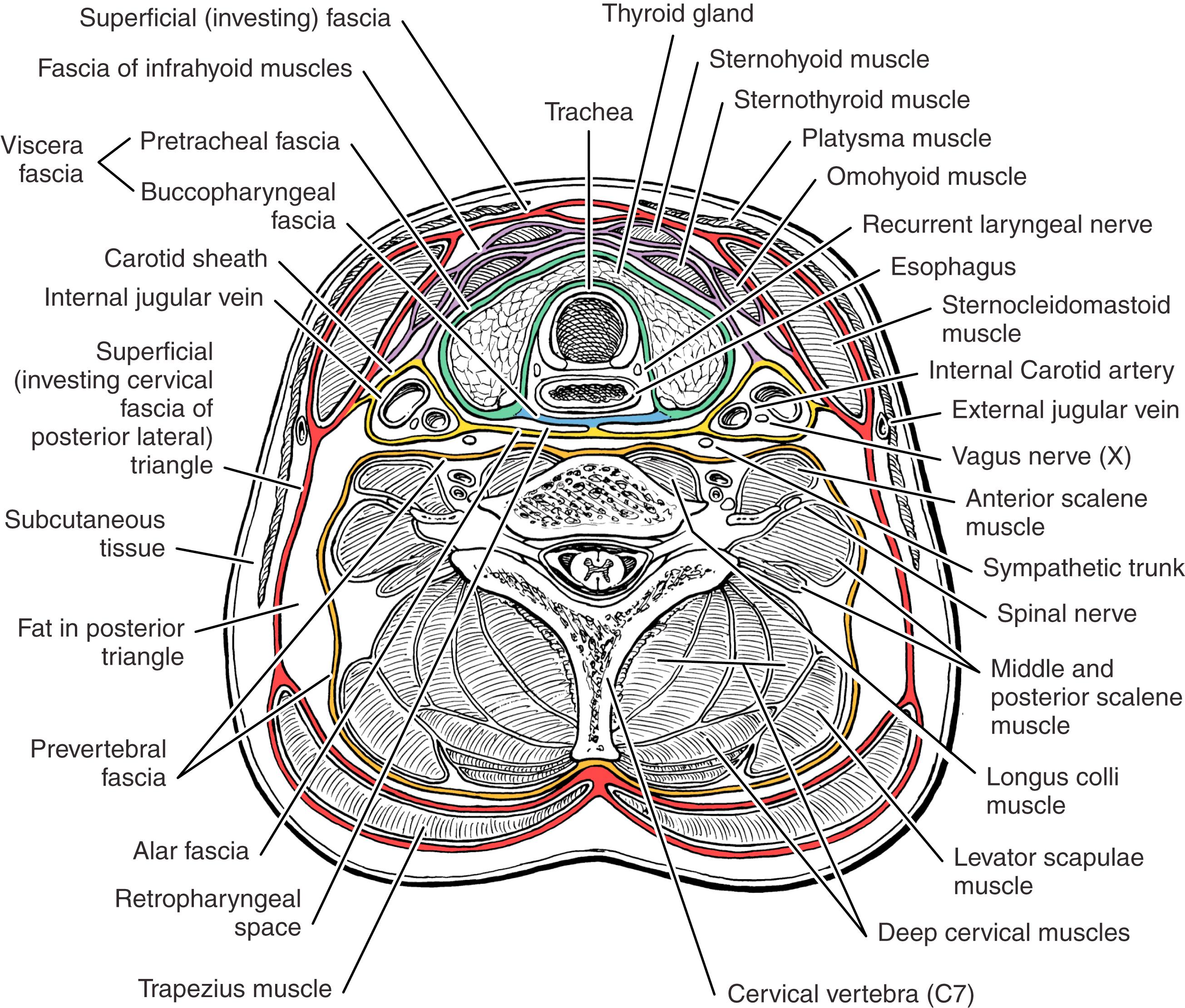
The triangles of the neck ( Fig. 23.2 ) are three-dimensional structures that should be visualized as pyramidal spaces; they not only have three sides but also have a roof (top) and a floor (bottom). In general terms, each triangle is bounded by bone and muscles with distinct fascial layers that form the roof and floor. Each contains blood vessels, nerves, lymphatic vessels, and lymph nodes. The development of many structures in the head and neck is intimately related to the pharyngeal (formerly termed branchial) apparatus. These transient embryonic structures undergo substantial remodeling such that their original embryonic form is essentially unrecognizable by the time a child is born. Aberrations in pharyngeal apparatus development may produce significant malformations.
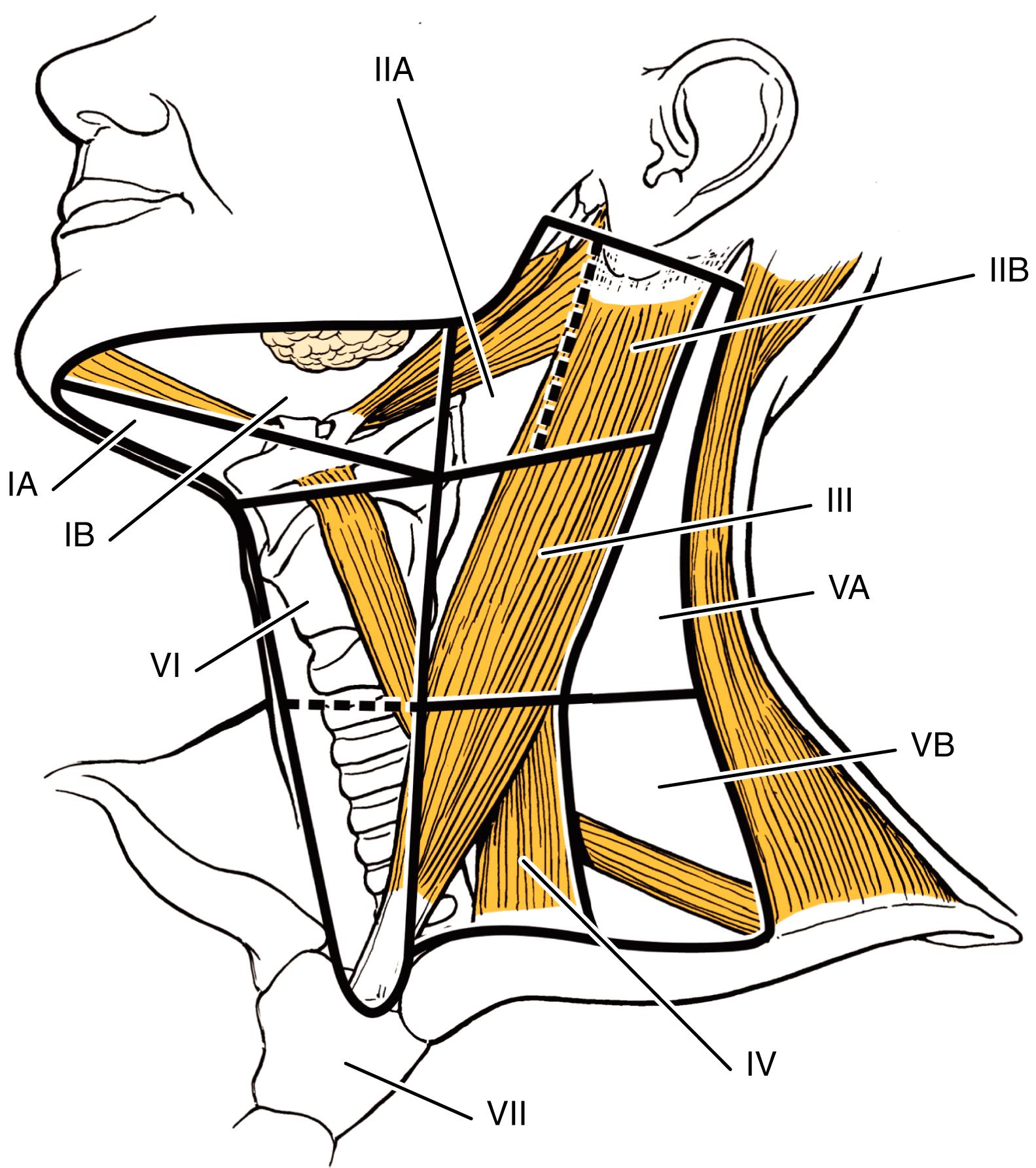
At approximately 4 to 5 weeks of gestation (24 to 29 days), the area of the future face and neck of the embryo consists of four or five pairs of fingerlike masses of tissue named the pharyngeal arches ( Fig. 23.3 ). The fifth arch never forms in humans, and there is no consensus regarding the sixth arch, as it cannot be readily seen externally. Prominent in lateral profile, these masses are aligned transversely to the plane of the neck and are separated externally by indentations, termed the pharyngeal clefts. The outer surfaces of the arches and the clefts are lined by ectoderm, whereas the substance of the pharyngeal arches contains mesoderm and neural crest cells. Thus the pharyngeal arches give rise to structures composed of muscle, bone, or like derivatives. The first pharyngeal cleft contributes to the external auditory canal and the outer layer of the tympanic membrane ( Fig. 23.4 ). The remaining second, third, and fourth branchial clefts do not give rise to identifiable structures in normally developed individuals; they fuse with the epicardial ridge in the lower part of the neck.
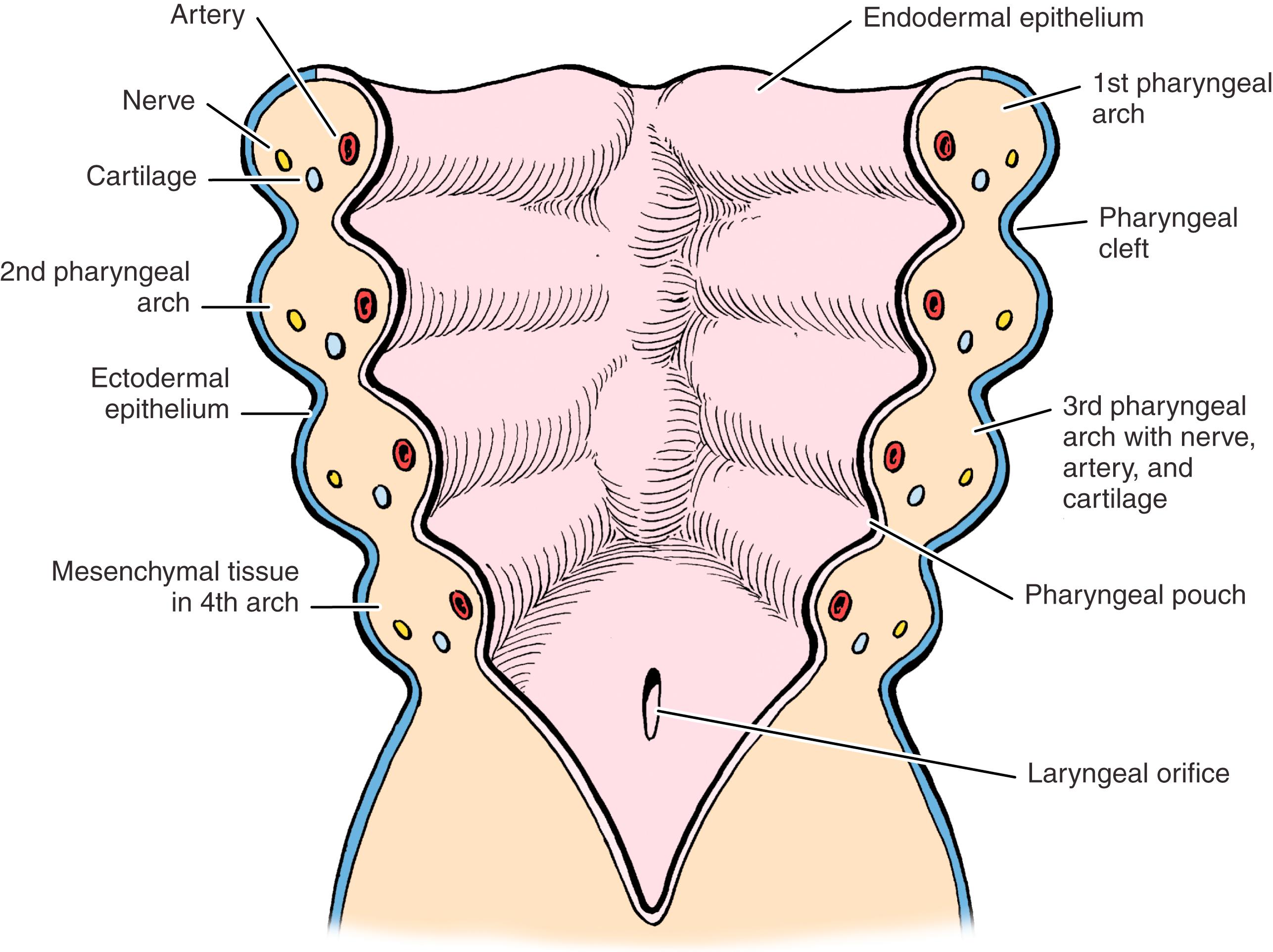
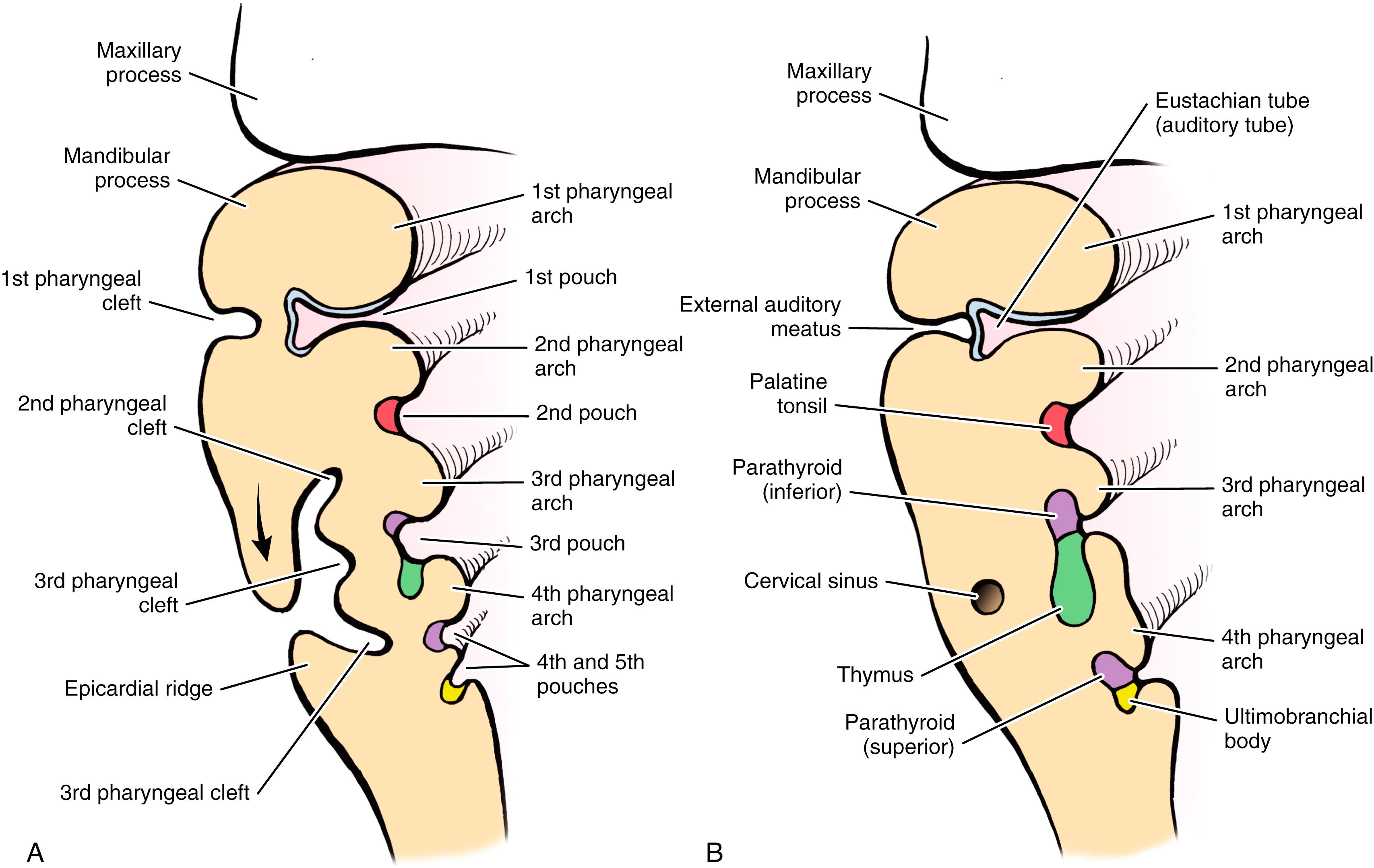
The pharyngeal pouches are lateral outpouchings from the foregut region (see Fig. 23.4 ) composed of endoderm; they develop into glandular or digestive tract elements. The endodermal lining contacts the ectodermal epithelium of the corresponding pharyngeal cleft at the extreme lateral wall of each pharyngeal pouch (see Fig. 23.4 ). Thus although the terms pharyngeal cleft and pharyngeal pouch are often used interchangeably, they refer to distinct structures. Occasionally, the term groove is used instead of pouch or cleft. The endodermal epithelial lining of the pharyngeal pouch contributes to the formation of specific elements of the pharynx in the adult.
In the early phase of pharyngeal arch development, the mesodermal mass of the arch forms a bar of cartilage, which remodels into bone, cartilage, or other connective tissue elements in the adult. Similarly, the adult musculature of the face and neck develops from the mesoderm of the pharyngeal arches. Each pharyngeal arch receives motor or sensory innervation and blood supply from an adjacent cranial nerve (CN) and associated artery, respectively. Structures derived from a particular pharyngeal arch retain their primary embryonic innervation and their vascular supply from the respective associated artery ( Table 23.1 ).
| Pharyngeal Arch | Arch Artery | Skeletal Elements | Muscles | Cranial Nerve |
|---|---|---|---|---|
| 1 | Terminal branch of internal maxillary artery | Meckel cartilage: mandibular ramus, mandibular body, malleus (except manubrium), incus (except long process) Maxillary process: forms alisphenoid, premaxilla, maxilla, zygoma, squamous portion of temporal bone |
Muscles of mastication (temporalis, masseter, medial pterygoid, lateral pterygoid), mylohyoid, anterior belly of digastric, tensor tympani, tensor veli palatini | Maxillary and mandibular divisions of trigeminal nerve (V2 and V3) |
| 2 | Stapedial artery (embryonic) Caroticotympanic artery |
Reichert cartilage: styloid process, manubrium of malleus, long process of incus, stapes superstructure, stylohyoid ligament, superior hyoid body, lesser cornu of hyoid | Muscles of facial expression (orbicularis oculi, orbicularis oris, risorius, platysma, auricularis, frontalis, buccinator), posterior belly of digastric, stylohyoid, stapedius | Facial nerve (CN VII) |
| 3 | Common carotid, internal carotid artery | Inferior body and greater cornu of hyoid | Stylopharyngeus muscle | Glossopharyngeal nerve (CN IX) |
| 4 | Aortic arch (between carotids), right subclavian artery | Thyroid cartilage, cuneiform laryngeal cartilages, epiglottis | Pharyngeal constrictors, cricothyroid, levator veli palatini | Superior laryngeal branch of vagus nerve (CN X) |
| 6 | Ductus arteriosus, pulmonary artery roots | Cricoid cartilage, arytenoid cartilages, corniculate cartilages | Intrinsic laryngeal muscles (except cricothyroid), striated muscle in upper esophagus | Recurrent laryngeal branch of vagus nerve (CN X) |
The trigeminal nerve supplies motor innervation to all the muscles derived from the first pharyngeal arch. In addition, sensory innervation is provided to the region of the mandible via the third division of the trigeminal nerve and to the maxillary process of the first arch and the frontal nasal process via the second (maxillary) and first (ophthalmic) division, respectively. Skeletal derivatives of the first arch include the proximal part of the Meckel cartilage, which is remodeled and contributes to the formation of the ramus of the mandible ( Fig. 23.5 ). The distal part of the cartilage withers, and the body of the mandible is formed from intramembranous bony growth. Other structures formed by the proximal part of the Meckel cartilage are the sphenomandibular ligament, anterior malleolar ligament, malleus (except the manubrium), and incus (except for its long process). The maxillary process is derived from the dorsal portion of the first arch and contributes to the development of the premaxilla, maxilla, zygoma, and part of the temporal bone.
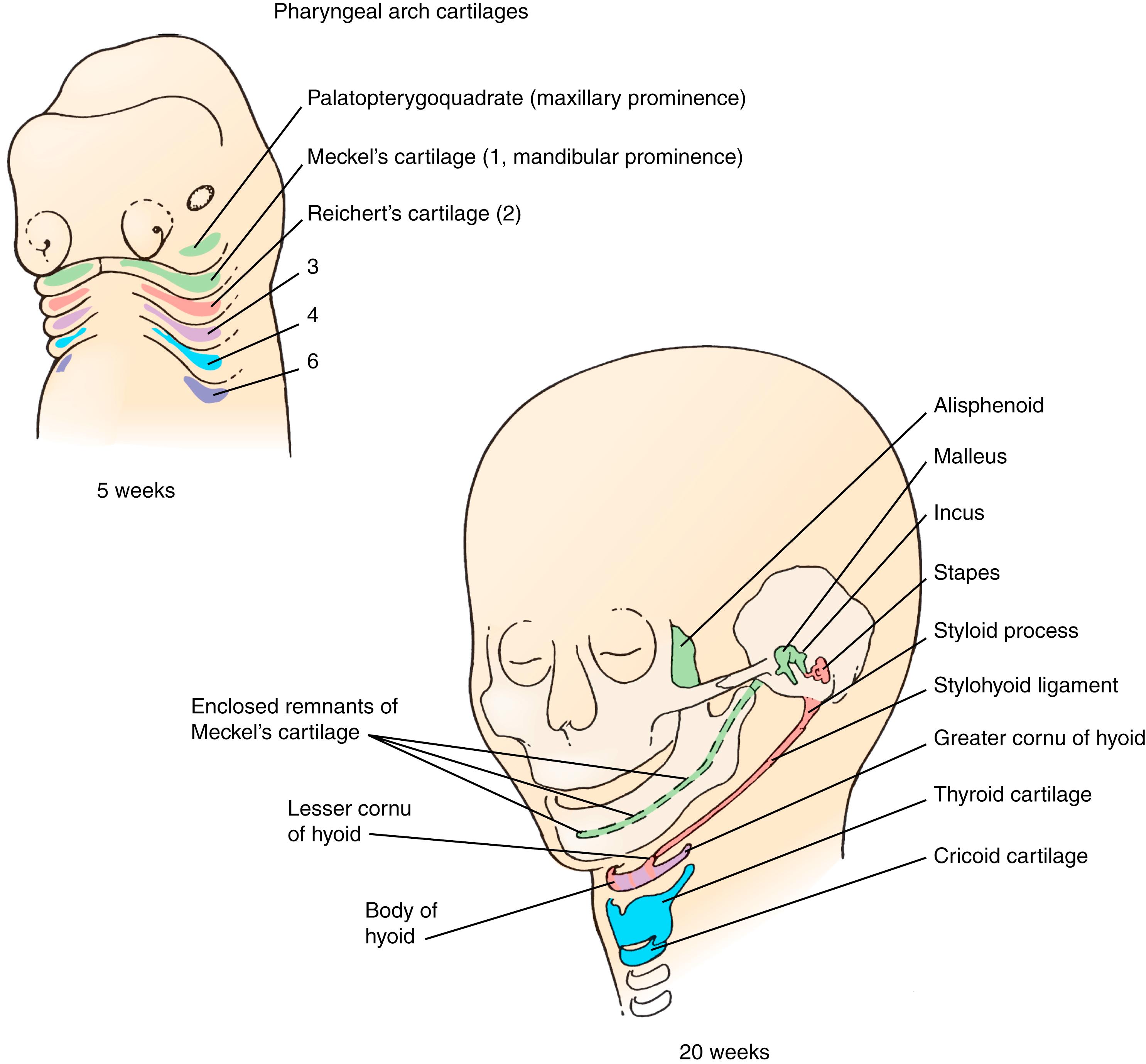
The facial nerve is the nerve of the second pharyngeal arch and supplies motor innervation to all of the muscles derived from this mesoderm, namely the muscles of facial expression. Other than a small sensory branch of CN VII, which may supply part of the external auditory meatus, there is no sensory distribution of CN VII to ectoderm. The second pharyngeal arch artery is the stapedial artery, which only rarely persists. The Reichert cartilage of the second pharyngeal arch forms bony structures proximally and distally. Its central portion withers, leaving a fibrous band called the stylohyoid ligament . Proximally, it forms the styloid process, manubrium of the malleus, long process of the incus, and stapes suprastructure (see Fig. 23.5 ). The stapes footplate is mostly derived from the otic capsule. , Distally (anteroinferiorly), the second arch’s cartilage forms the superior portion of the body and the lesser cornu of the hyoid bone. In the adult, the path of the embryonic second arch cartilage can be traced from the styloid process to the stylohyoid ligament, ending at the lesser cornu of the hyoid bone (see Fig. 23.5B ).
CN IX (the glossopharyngeal nerve) supplies the motor innervation to the stylopharyngeus, which is the only muscle derived from the third arch, and sensory innervation to parts of the pharynx. The cartilage elements derived from the third arch form the remaining portions of the hyoid bone (i.e., the inferior body and greater cornu; see Fig. 23.5 ).
The vagus nerve and the cranial part of the accessory nerve supply the muscles derived from the fourth (superior laryngeal branch of the vagus) and sixth (recurrent laryngeal branch of the vagus) pharyngeal arches; the fifth arch structures undergo resorption. Originating in the nucleus ambiguus of the medulla, the axonal processes of these nerves descend in the vagus nerve after they exit the skull via the jugular foramen. Specifically, the pharyngeal constrictors are supplied by the pharyngeal branch of the vagus, and the transitional portion of the pharynx and esophagus is supplied via the recurrent laryngeal branch of the vagus. The superior laryngeal nerve supplies sensation to the larynx via its internal branch and provides motor innervation to the cricothyroid muscle via the external branch. The recurrent laryngeal nerve supplies the intrinsic muscles of the larynx. The arch of the aorta between the common carotid and subclavian arteries and the right proximal subclavian artery are derived from the fourth branchial arch. The sixth arch gives rise to the ductus arteriosus on the left and the proximal right pulmonary artery on the right.
The fourth and sixth pharyngeal arches contribute to the formation of the thyroid and cuneiform laryngeal cartilages from the fourth arch and the cricoid, arytenoid, and corniculate cartilages from the sixth arch (see Fig. 23.5 ). The mesoderm from the fourth through sixth pharyngeal arches forms the muscles that make up the pharynx and larynx. Pharyngeal muscles include the levator veli palatini and pharyngeal constrictor muscles. In addition, the mesodermal elements from these pharyngeal arches form the striated muscle that composes the upper half of the esophagus. The inferior part of the esophagus is usually composed of smooth muscle derived from the splanchnic mesoderm of the primitive foregut. The laryngeal muscles are also formed from mesodermal elements in the fourth, fifth, and sixth arches. These include the extrinsic laryngeal muscles, the thyroepiglottic, aryepiglottic, and cricothyroid, and the intrinsic muscles associated with movement of the arytenoid cartilages and true and false vocal folds, the posterior cricoarytenoid, lateral cricoarytenoid, transverse arytenoid, and oblique arytenoid muscles.
The first pharyngeal pouch becomes elongated and is incorporated into the temporal bone and forms the tubotympanic recess, which eventually becomes the middle ear and eustachian tube (see Fig. 23.4 ). The most lateral portion of the pouch, along with the closing plate of the first pharyngeal cleft, forms the inner layer of the tympanic membrane and, as noted earlier, the external auditory canal is formed from remodeling of the first pharyngeal cleft. The endodermal layer of the second pharyngeal pouch forms the epithelial lining of the tonsillar fossa and palatine tonsil, whereas the underlying mesenchymal elements contribute to the incorporation of the lymphoid tissue of the tonsil proper (see Fig. 23.4 ). An animated illustration of the derivatives of the pharyngeal pouches is available online at the Indiana University Human Embryology Animations website.
The region of the third pharyngeal pouch is subdivided into superior and inferior portions. The superior portion forms cells that eventually differentiate into the paired inferior parathyroid glands; the inferior portion of the third pouch forms thymic tissue, which eventually migrates into the neck and retrosternal mediastinum to form the thymus (see Figs. 23.4 and 23.6 ). Aberrant migration of the third pharyngeal pouch may result in ectopic inferior parathyroid or thymus tissue.
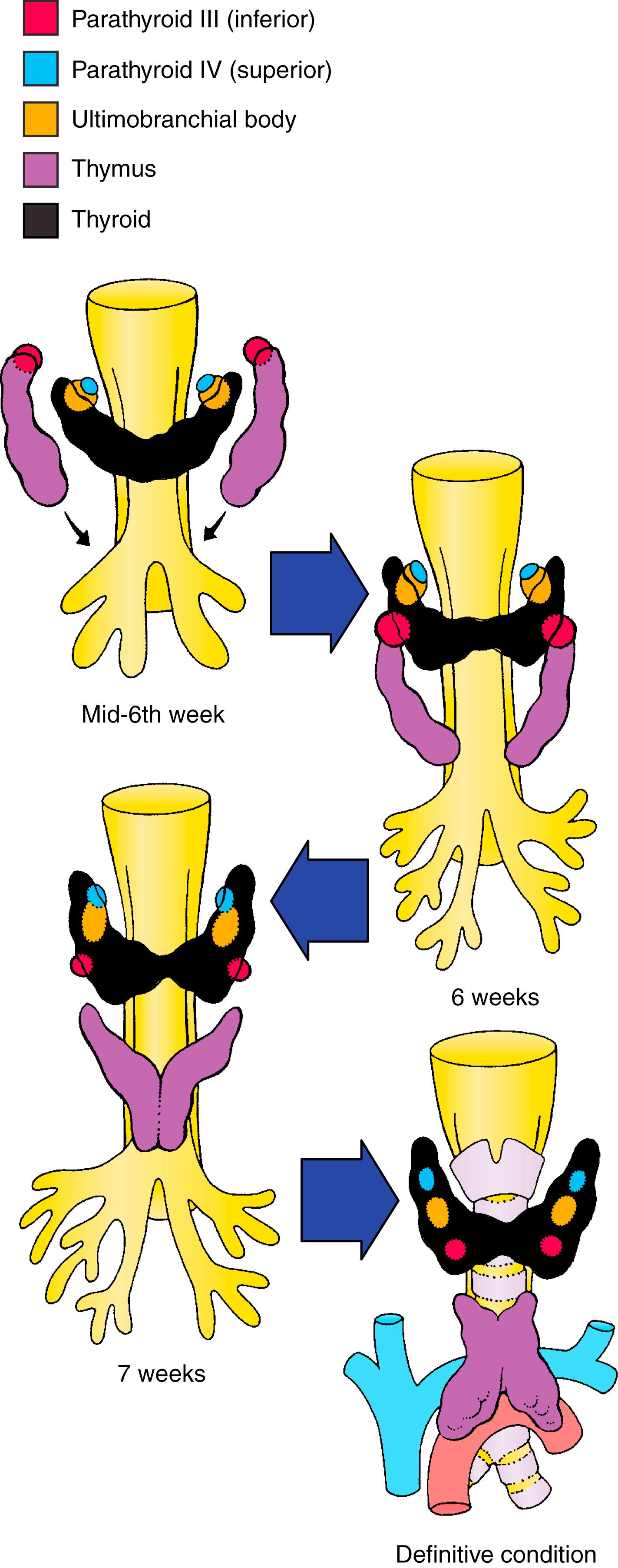
The endoderm of the fourth pouch forms the parathyroid glands in the superior poles of the thyroid gland. The adjacent area is variably named as the fifth pouch, sixth pouch, or ultimobranchial body (see Fig. 23.6 ). Subsequently, the ultimobranchial body is infiltrated by cells that migrate from the neural crest region. These cells are eventually incorporated into the thyroid gland and become the parafollicular cells (C cells) that are responsible for the secretion of calcitonin. ,
Pharyngeal arches 1 through 4 all contribute to the development of the tongue ( Fig. 23.7 ). At 4 weeks of gestation, the lateral lingual swelling and medial lingual swelling or tuberculum impar from the first branchial arch form the anterior two thirds of the tongue. Sensory innervation comes from the lingual nerve of the mandibular branch of the trigeminal nerve, and taste sensation is carried on the chorda tympani, a branch of the facial nerve. The posterior one third of the tongue develops from the copula or hypobranchial eminence, which arises from the second, third, and fourth pharyngeal arches. Sensory and taste innervation is carried primarily on the glossopharyngeal nerve from the third arch, although the posterior tongue (vallecula) and epiglottis are innervated by the superior laryngeal branch of the vagus nerve from the fourth arch. The junction between the anterior and posterior tongue is V shaped and is called the terminal sulcus. The intrinsic tongue musculature differentiates from migration of myoblasts from occipital somites and is innervated by the hypoglossal nerve except for the palatoglossus, which is innervated by the pharyngeal plexus of the vagus ( Fig. 23.8 ).
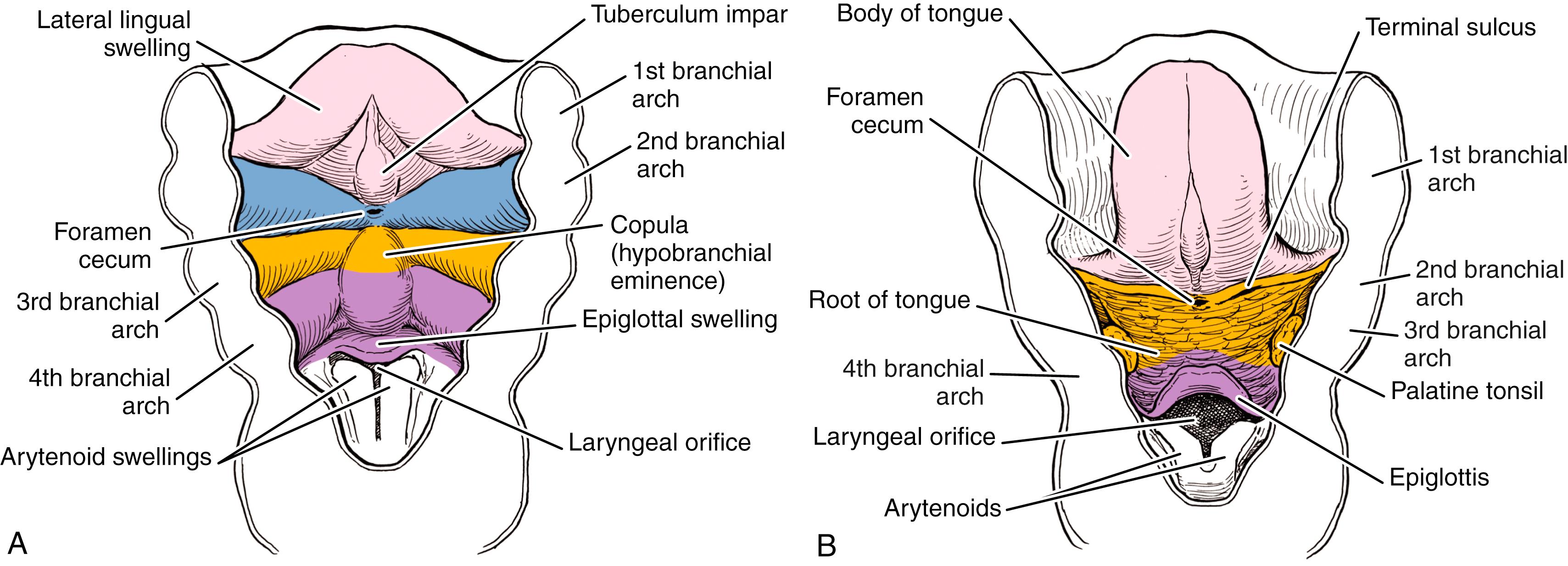
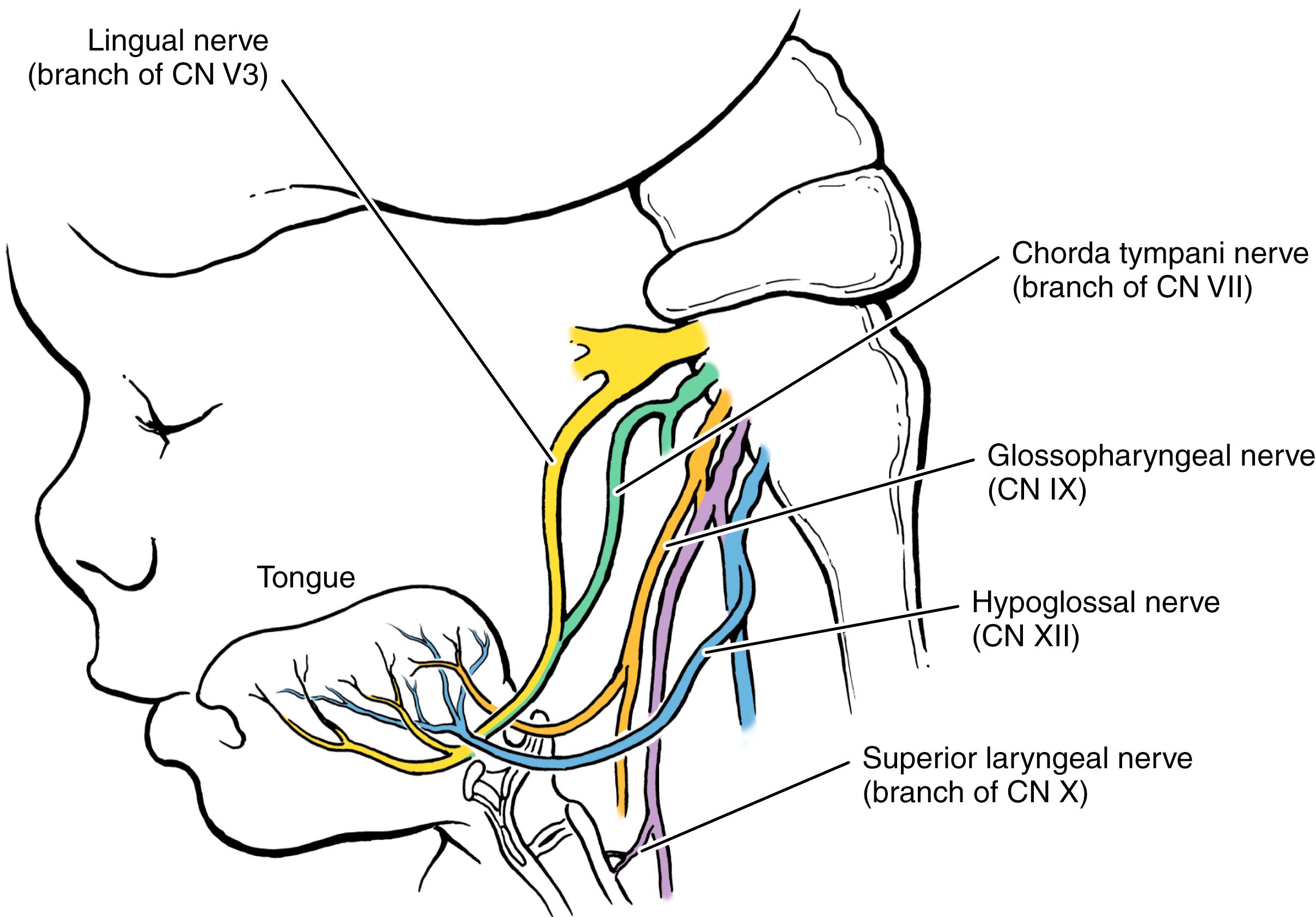
The thyroid gland begins as a solid swelling of endoderm in the midline of the posterior one third of the tongue. The point of origin is known as the foramen cecum, which invaginates around the fifth week of embryonic development. The thyroglossal duct descends inferiorly in the developing neck between the second and third arches and therefore, when persistent, may be included within the body of the hyoid bone ( Fig. 23.9 ). By the seventh week, the thyroid gland reaches its final destination in the neck just inferior to the cricoid cartilage anterior to the trachea. At the same time, the parathyroid glands take their positions adjacent to the thyroid gland, and the ultimobranchial body (derived from neural crest cells) infiltrates the posterior aspect of the lateral thyroid lobes. The thyroid gland is functional by the 10th to 12th week of development. Abnormal migration of the thyroid gland may result in ectopic thyroid tissue. The tract of the migration of the thyroid gland, termed the thyroglossal duct, normally collapses and atrophies; when it persists, a thyroglossal duct cyst forms.
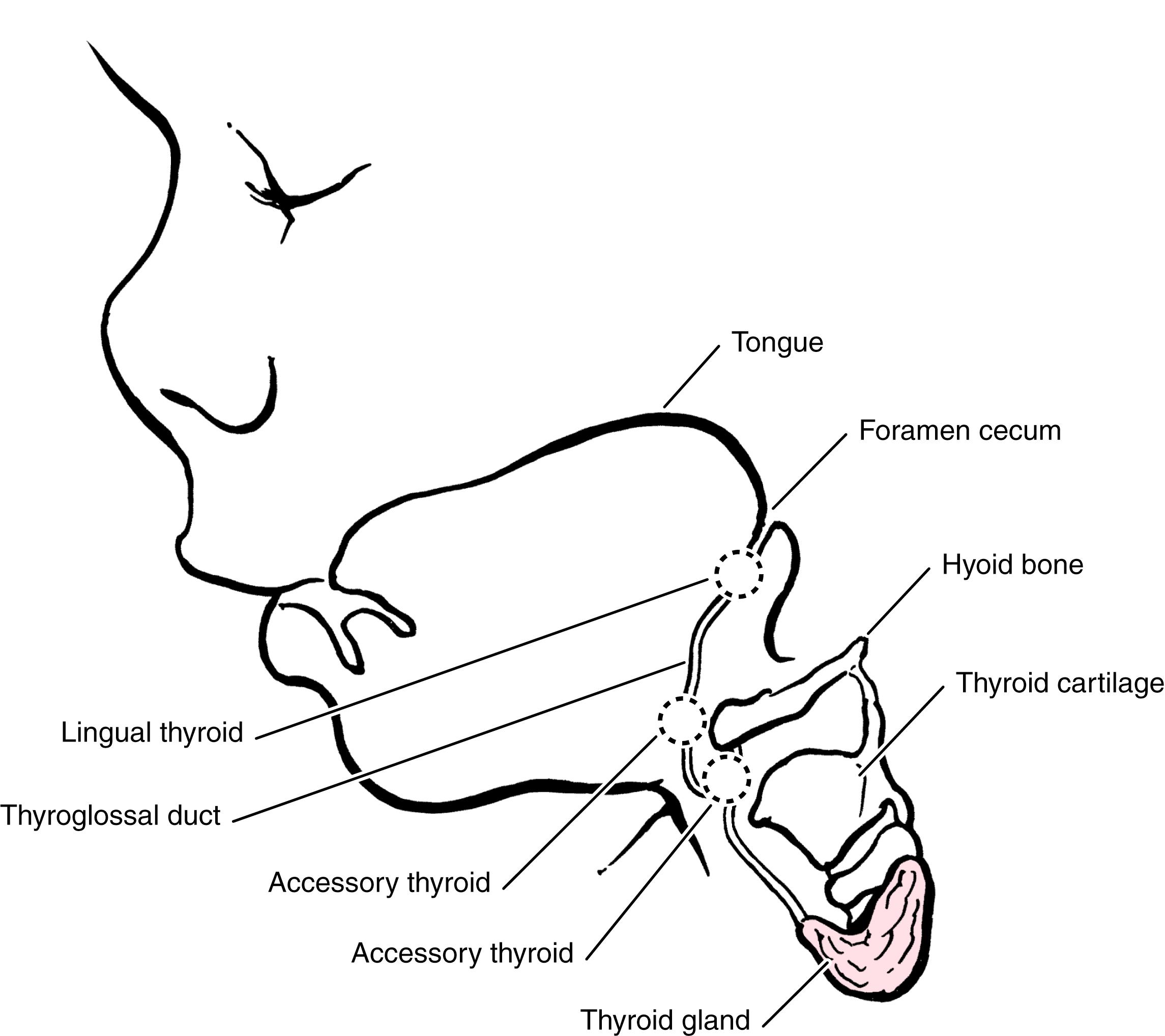
A child with a neck mass presents a vast differential diagnosis ( Box 23.1 ) ranging from completely innocuous to immediately life-threatening conditions. The vast majority of pediatric neck masses are benign and resolve without intervention. The challenge for the otolaryngologist is to collect and assimilate the information needed to detect high-risk, rare conditions while avoiding an invasive and costly workup and undue parent distress for common and innocuous lesions. A systematic approach in evaluation can allow the clinician to narrow the differential and diagnose the lesion through a tailored workup.
Branchial cleft anomalies
Thyroglossal duct cyst
Dermoid cyst
Bronchogenic cyst
Thymic cyst
Epidermal inclusion cyst
Pilomatrixoma
Fibromatosis coli
Ectopic thymus
Ectopic thyroid
Foregut duplication cyst
Choristoma
Accessory tragus
Cervical rib
Become a Clinical Tree membership for Full access and enjoy Unlimited articles
If you are a member. Log in here